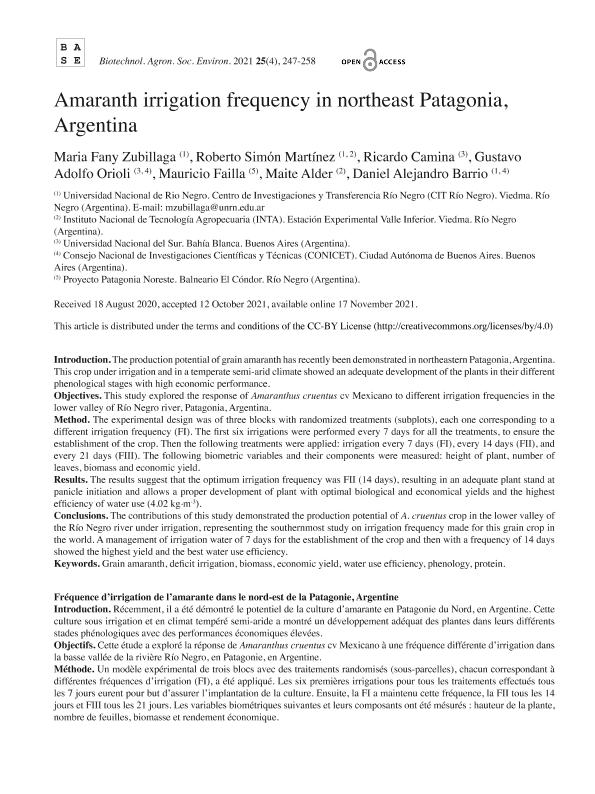Artículo
Introduction. The production potential of grain amaranth has recently been demonstrated in northeastern Patagonia, Argentina. This crop under irrigation and in a temperate semi-arid climate showed an adequate development of the plants in their different phenological stages with high economic performance. Objectives. This study explored the response of Amaranthus cruentus cv Mexicano to different irrigation frequencies in the lower valley of Río Negro river, Patagonia, Argentina. Method. The experimental design was of three blocks with randomized treatments (subplots), each one corresponding to a different irrigation frequency (FI). The first six irrigations were performed every 7 days for all the treatments, to ensure the establishment of the crop. Then the following treatments were applied: irrigation every 7 days (FI), every 14 days (FII), and every 21 days (FIII). The following biometric variables and their components were measured: height of plant, number of leaves, biomass and economic yield. Results. The results suggest that the optimum irrigation frequency was FII (14 days), resulting in an adequate plant stand at panicle initiation and allows a proper development of plant with optimal biological and economical yields and the highest efficiency of water use (4.02 kg.m-3). Conclusions. The contributions of this study demonstrated the production potential of A. cruentus crop in the lower valley of the Río Negro river under irrigation, representing the southernmost study on irrigation frequency made for this grain crop in the world. A management of irrigation water of 7 days for the establishment of the crop and then with a frequency of 14 days showed the highest yield and the best water use efficiency. Introduction. Récemment, il a été démontré le potentiel de la culture d’amarante en Patagonie du Nord, en Argentine. Cette culture sous irrigation et en climat tempéré semi-aride a montré un développement adéquat des plantes dans leurs différents stades phénologiques avec des performances économiques élevées. Objectifs. Cette étude a exploré la réponse de Amaranthus cruentus cv Mexicano à une fréquence différente d’irrigation dans la basse vallée de la rivière Río Negro, en Patagonie, en Argentine. Méthode. Un modèle expérimental de trois blocs avec des traitements randomisés (sous-parcelles), chacun correspondant à différentes fréquences d’irrigation (FI), a été appliqué. Les six premières irrigations pour tous les traitements effectués tous les 7 jours eurent pour but d’assurer l’implantation de la culture. Ensuite, la FI a maintenu cette fréquence, la FII tous les 14 jours et FIII tous les 21 jours. Les variables biométriques suivantes et leurs composants ont été mésurés : hauteur de la plante, nombre de feuilles, biomasse et rendement économique. Résultats. Les résultats suggèrent que FII est la fréquence d’irrigation optimale. Cette fréquence d’irrigation génère un peuplement adéquat à l’initiation des panicules et permet un développement correct de la plante avec des rendements biologiques et économiques optimaux et la meilleure efficacité d’utilisation de l’eau (4,02 kg.m-3). Conclusions. Cette étude a démontré le potentiel de culture de A. cruentus dans la basse vallée de la rivière Río Negro, représentant l’étude de la densité d’installation réalisée pour cette culture de céréales la plus australe au monde. Une gestion de l’eau d’irrigation de 7 jours pour la mise en place de la culture puis avec une fréquence de 14 jours a montré le rendement le plus élevé et la meilleure efficacité d’utilisation de l’eau.
Amaranth irrigation frequency in northeast Patagonia, Argentina
Título:
Fréquence d’irrigation de l’amarante dans le nord-est de la Patagonie, Argentine
Zubillaga, Maria Fany ; Martínez, Roberto Simón; Camina, Ricardo; Orioli, Gustavo Adolfo
; Martínez, Roberto Simón; Camina, Ricardo; Orioli, Gustavo Adolfo ; Failla, Mauricio; Alder, Maite; Barrio, Daniel Alejandro
; Failla, Mauricio; Alder, Maite; Barrio, Daniel Alejandro
 ; Martínez, Roberto Simón; Camina, Ricardo; Orioli, Gustavo Adolfo
; Martínez, Roberto Simón; Camina, Ricardo; Orioli, Gustavo Adolfo ; Failla, Mauricio; Alder, Maite; Barrio, Daniel Alejandro
; Failla, Mauricio; Alder, Maite; Barrio, Daniel Alejandro
Fecha de publicación:
11/2021
Editorial:
Fac Univ Sciences Agronomiques Gembloux
Revista:
BIOTECHNOLOGIE, AGRONOMIE, SOCIéTé ET ENVIRONNEMENT
ISSN:
1370-6233
e-ISSN:
1780-4507
Idioma:
Inglés
Tipo de recurso:
Artículo publicado
Clasificación temática:
Resumen
Archivos asociados
Licencia
Identificadores
Colecciones
Articulos(SEDE CENTRAL)
Articulos de SEDE CENTRAL
Articulos de SEDE CENTRAL
Citación
Zubillaga, Maria Fany; Martínez, Roberto Simón; Camina, Ricardo; Orioli, Gustavo Adolfo; Failla, Mauricio; et al.; Amaranth irrigation frequency in northeast Patagonia, Argentina; Fac Univ Sciences Agronomiques Gembloux; BIOTECHNOLOGIE, AGRONOMIE, SOCIéTé ET ENVIRONNEMENT; 25; 4; 11-2021; 247-258
Compartir
Altmétricas



